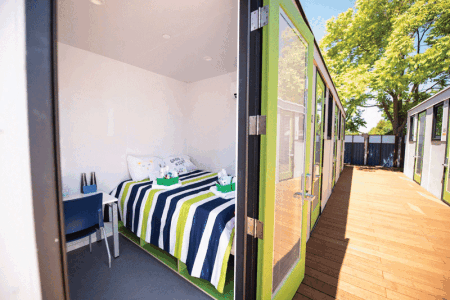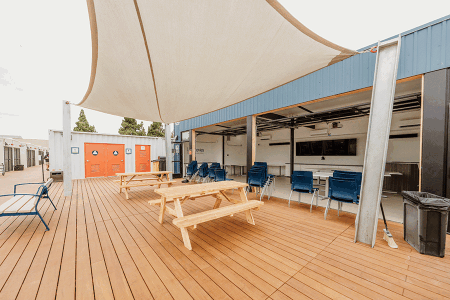A few years ago, veteran multifamily real estate developer and longtime ULI member Preston Butcher was on a street in Mountain View, California, when an unusual sort of housing complex caught his attention.
Preston Butcher, the chairman of Legacy Partners, has built elegant-looking apartment buildings across a wide swath of the western U.S., from Dallas all the way to Seattle. But LifeMoves Mountain View, the development he admired, was something different. It consists of 100 small, boxy, modular dwellings that provide separate units for single adults, couples, and families experiencing homelessness, as well as support services and case management designed to help the residents eventually regain stability in their lives.
Preston Butcher wasn’t just attracted by the project’s altruistic mission, though. “My background is in development, so I was impressed by the construction and the design,” he recalls. “So I started asking questions.”
As he learned more about the project and the larger subject of building for the unhoused, he had a sudden revelation: “You would never start an office building, a warehouse, or an apartment house without knowing all about your competitors, and what they charge.”
But builders of housing aimed at the homeless didn’t have similar market intelligence to study. “You had these different organizations building structures, and some were very inefficient and terribly expensive,” Preston Butcher explains. “Others were very efficient and less expensive. I thought, we need to put together comparables and gather best practices of projects that are successful so we can show people, these are the ones that work.”
Preston Butcher envisioned a new, businesslike approach to finding solutions for homelessness, a problem that affects numerous Americans. (A snapshot of homelessness compiled by the U.S. Department of Housing and Urban Development found that on a single night in 2022, 582,462—or about 18 of every 10,000 people in the U.S.—experienced homelessness.)
And he knew of an organization with the right mix of technical experts in just about every aspect of real estate development to tackle it.
“I called Mary Beth [Corrigan, senior vice president at ULI] and said, here’s what I think we ought to do,” Preston Butcher recalls. His initial inspiration and philanthropic support led to the publication of a June 2022 report, “Homeless to Housed: The ULI Perspective Based on Actual Case Studies,” which presents detailed analyses of—and specifications for—eight successful efforts to house the homeless, from North Carolina to California. The report also seeks to dispel negative misconceptions about the homeless, and focuses on government intervention and upon the potential for the private-sector residential development segment of the industry to join in working toward a solution.
But that was just the start. In September 2022, Preston Butcher and his wife, Carolyn, donated $1.5 million to fund the ULI Homeless to Housed Initiative. The ongoing effort is within the ULI Terwilliger Center for Housing, which aims to gather and disseminate further information about innovative solutions for homelessness, as well as to fund projects by ULI District Councils that are related to homelessness, and to give ULI members opportunities to get involved in their communities.
The generosity and commitment of Preston Butcher and other members is helping to drive what could be a major transformative effort to solve one of the nation’s most perplexing and tragic dilemmas.

Interior of a LifeMoves Mountain View dwelling in Mountain View, Calfornia. The project inspired veteran multifamily developer and ULI member Preston Butcher to provide philanthropic support for a June 2022 report, “Homeless to Housed: The ULI Perspective Base on Actual Case Studies.” (Office of Charles F. Bloszies/GC XL Construction)
ULI’s evolving efforts
One thing that sets apart Homeless to Housed is the initiative’s focus on homelessness as both a housing issue and a social problem.
“There are a lot of experts working in the homeless space that are really good at understanding the moral reasons to explore homelessness, the social service side of homelessness,” says Will Herbig, senior director of ULI’s Homeless to Housed Initiative. “But I think there is a struggle, particularly in the U.S., in understanding the housing side of homelessness.”
Herbig says the initiative fits within the Terwilliger Center’s aim of advancing the full spectrum of housing opportunities, particularly for low- and moderate-income households. Unlike with conventionally affordable worker housing, however, which aims to provide a place to live for workers who have been priced out of competitive housing markets, “When we’re talking about the unhoused, we’re talking about folks who really have no income, or very little income,” Herbig says.
As a result, Homeless to Housed seeks ways to create “deeply affordable” housing, which is aimed at people whose earnings are less than, or equal to, 30 percent of the area median income, Herbig explains.
Another key aspect of Homeless to Housed is the program’s recognition that such housing must be connected to what Herbig describes as “meaningful support services.” They include help for people with underlying mental health or substance abuse issues, but also other sorts of help. “We often forget about needed infrastructure services, such as proximity to reliable transportation, transit, and health care,” he says.
“We must look at what [the tools are] to make that work,” Herbig says. “And not only . . . the tools—we got to actually build the units. But then, what are the tools to actually operate those units? It’s often easier to build a building than it is to operate the building in perpetuity.”
Herbig also emphasizes the necessity of weighing solutions across a full spectrum. “That means permanent supportive housing, both new construction and retrofits,” he says. “It means temporary one-story solutions. We’re interested in the innovations that are out there. We want to showcase [all] tools in the toolbox for commercial real estate leaders and partners to advance solutions to the growing humanitarian and economic crisis facing unhoused individuals and families. This includes understanding the policy barriers [to] advancing rapidly deployable and cost-effective solutions.”
To that end, Herbig says the Homeless to Housed effort includes three core elements:
Research: Homeless to Housed will build upon the original 2022 report by continuing to gather information on innovative approaches and adding three to six new case studies annually.
Building awareness: “We want to spur meaningful conversations at all levels of ULI,” Herbig says. That includes “meaningful conversations at the Spring and Fall Meetings, articles in Urban Land, discussions in our district councils, and dialog-building events.”
Local technical assistance: Homeless to Housed aims to tap into the talent and expertise of ULI’s network of district councils by funding technical assistance/innovation grants that address homelessness issues.
The initiative is already supporting its first group of such projects by providing $115,000 in total to councils in Philadelphia; San Antonio; San Diego; San Jose (via ULI San Francisco); and Lafayette, Louisiana (via ULI Louisiana). Each council is investigating a different aspect of dealing with homelessness, including how to preserve temporary housing created during the COVID-19 pandemic and leveraging property owned by faith-based communities.
“ULI members are the brick-and-mortar folks, and this expertise is needed in the conversation,” Herbig says. “ULI members bring [knowledge] in how to leverage capital, finance, construction innovation, all [of which are] required to bring projects to market . . . whether those are traditional buildings or temporary one-story approaches. ULI expertise is needed to move the needle.”
“At ULI, we’re not experts on homelessness,” Herbig notes. “We can’t go at this alone. To be successful, we have to partner with the experts in the field who’ve long been working on the issue, and [who] understand the nuances and the unique sensitivity that this conversation needs to have. If we can do that, my hope is that we’ll have a transformative impact.”
Social entrepreneurship
Charlotte-based developer and ULI member Philip Payne—who has served as an adviser to Homeless to Housed and who wrote a portion of the initial 2022 report—first became engaged in the issue during 2017, after he went to Los Angeles to take part in an Advisory Services Panel on homelessness there. Payne says the experience led him to contemplate how to get the real estate industry involved in a solution.
Payne got back home and called Beth Silverman, who at the time was a ULI vice president, and got together with her and Molly McCabe, founder and CEO of real estate advisory firm HaydenTanner, to have another discussion. The result was the Lotus Campaign, a nonprofit organization that facilitates housing-driven solutions to homelessness. (Silverman is now the campaign’s executive director, while Payne serves as chair and McCabe is a director.)
One of Lotus’ key programs connects people who are at risk of homelessness with landlords who have available units but might be reluctant to rent to them over concerns that they will be unable to keep up with the rent or may damage the property.
To eliminate those concerns, Lotus makes a nonrefundable payment—the equivalent of 8 to 12 percent of the annual rent—in lieu of a deposit as an incentive to landlords. It also guarantees rent payments and covers any damage. In essence, Lotus becomes the equivalent of “the parent on a student’s lease,” Payne says.
Lotus also arranges for the tenant to receive “intensive social service support” from various agencies during the lease term, including home visits at least once a month. If a problematic tenant needs to be evicted, Lotus—after exhausting other approaches—will even appear in court on the landlord’s behalf.
Since Lotus began the program several years ago, it has facilitated housing for about 420 people, including approximately 270 who benefited enough from the stability bestowed that they eventually were able to live independently. “There’s been a grand total of one eviction,” Payne says. Lotus has had to cover less than $50,000 in lost rent and damage, with most of the expense related to the COVID-19 pandemic. The program’s track record is so good that some landlords now waive the upfront incentive payment.
Lotus also helps improve housing availability by investing in multifamily residential properties. In 2018, for example, the organization partnered with a real estate company to purchase a 144-unit multifamily development in southwest Charlotte and was able to reserve 30 of the units for Lotus Campaign clients.
Payne, who’s currently writing a paper for ULI on innovative solutions to homelessness, thinks it’s time to start viewing the real estate industry as an important participant in remedying the problem. He doesn’t see private-sector efforts as competing with government ones but, instead, as a means to free public resources to be deployed in other ways.
If more ULI donors step up to support Homeless to Housed, that might enable the initiative to have an even larger impact on homelessness, and lead to solutions that could ease the suffering and hardship of hundreds of thousands of people in need.
“The problem is too big if we don’t step up to help,” Payne says.
PATRICK J. KIGER is a Washington, D.C.–based journalist.







